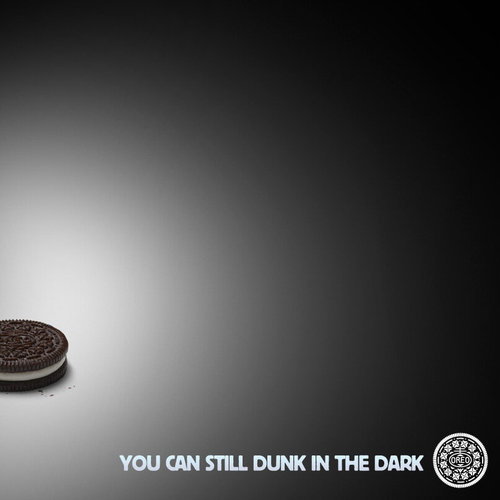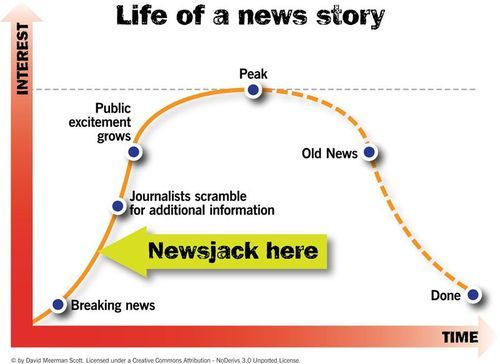
While the lights were out at the Super Bowl, Nabisco sent out a tweet with an image of an Oreo cookie and the caption: “You can still dunk in the dark.” The free tweet garnered as much post game attention as many of the million dollar commercials and also showed how quick and clever social media marketing can outpace the most expensive mainstream campaigns.
While I can’t say I have ever made national news from a clever, well-timed tweet, I can say that one can regularly get news coverage by jumping on a trend or taking advantage of breaking news. It’s actually a cornerstone of media relations, and one PR professional recently coined a term for it: “Newsjacking.”
Marketing guy David Meerman Scott wrote a book on the topic and also talked about it at South by Southwest (SXSW), the film, interactive and music festival/conference that takes place every spring in Austin, Texas. He defines it as “the process by which you inject your ideas or angles into breaking news, in real-time, in order to generate media coverage for yourself or your business.” You can buy his book at here. Most interesting to me was this graphic which shows the best time to capitalize on a breaking news story.

Most media relations pros have been newsjacking for decades. A couple years ago, we were discussing the latest happenings in the automobile dealer world with our client, attorney Alex Kurkin of Kurkin Brandes, and he mentioned that he was swamped with calls from his dealer clients who were confused about the “Cash for Clunkers” stimulus/rebate program. We jumped on the case and pitched his perspective to reporters around the country. We ended up securing several interviews for him, and he was widely quoted in the New York Times.
Last year, as Facebook was slowly rolling out its Timeline feature, we learned from our client The Lifeline Program that its senior citizen Facebook fans were up in arms about the change. Lifeline had switched its Facebook page to Timeline early to try to prevent confusion but instead got hit with blistering complaints from angry octogenarians (some of them can swear with the best of us). We quickly pitched this story to tech reporters who had been monitoring the big switch to Timeline, and a journalist from the San Jose Mercury News interviewed Steve Terrell of Lifeline. The story was picked up by dozens of newspapers around the country including the L.A. Times, Kansas City Star and Chicago Tribune.
And I did some newsjacking of my own recently. After writing a blog post early on about how Lance Armstrong could mount a comeback, we pitched our PR expertise and landed an interview with Metro in London. The reporter’s story was picked up by a number of outlets online including Spiegel in Germany. Call it an international newsjack.
My Keys to Newsjacking
In the interest of complete disclosure, I haven’t read Scott’s book. (It would probably just upset me that he thought of it first.) But I’m confident that I can offer some tips that can help anyone newsjack a national story.
Be quick. As Scott’s diagram shows, you have to identify a trend that you think will be national news before it reaches the top of the arc. For example, Lance Armstrong announced his intention to come clean on a Friday afternoon. I saw the story over the weekend and got inspired to blog about it. Our news release on the topic was distributed shortly after the news broke that he would appear on Oprah. We had some credibility because we had already posted about the topic, and we were ahead of other PR people with the same idea.
Use real examples. It’s not good enough that you are an expert on a topic. Wiggling your way into a big story requires you to have an opinion and hopefully some real world examples. For our client Alex Kurkin, he had firsthand experience with the chaos being created by Cash for Clunkers. Steve Terrell of Lifeline had been deleting expletive-laden comments written by angry seniors from his Facebook page. The examples give a story color, and an expert needs to talk specifics, not just generalities.
Take a position, now’s your chance to give your opinion. When major news is forming, people are starting to take sides. If you are on the “less popular” side, you have a better chance of getting coverage. I’m not suggesting you always look for the contrarian position, but it helps if you can make arguments for either position. Whenever I ask my commercial litigator brother Chris for his opinion about a legal case in the news, his answer is always the same: “What side am on?” Having a counter-balancing opinion can pay off.
Keep pushing. The PR game is a marathon, not a sprint. If you feel as though you can be an expert on short notice for national media, keep pushing for it. New stories come along every day, and the media’s attention shifts like the wind.
Have you ever newsjacked a national story? And more importantly, do you dunk your Oreos? Let me know.
—John
Author: John P. David